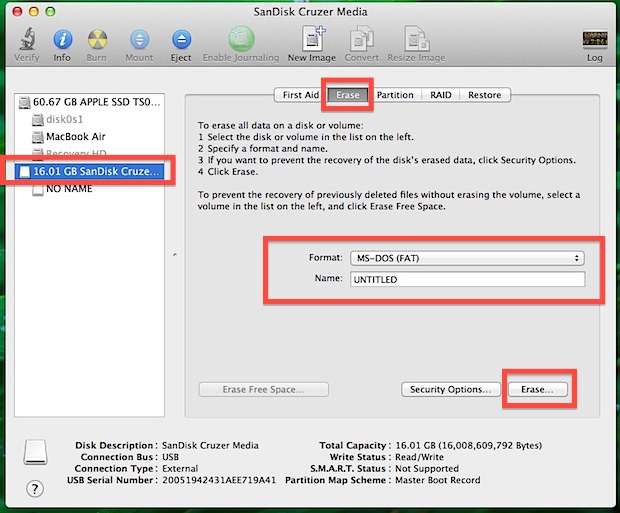

- Format a usb drive for a mac pro#
- Format a usb drive for a mac Pc#
- Format a usb drive for a mac mac#
This Mac 911 article is in response to a question submitted by Macworld reader Robin. Select the drive in the left-hand sidebar.įrom the Scheme menu, select Master Boot Record.Ĭlick Erase and follow prompts to confirm. Launch Disk Utility (from Applications > Utilities > Disk Utility). You can search for this from the Launchpad of your Mac. Once the USB drive is recognized, open the Disk Utility at once.

Then wait until the operating system recognizes it as a removable drive. The process of reformatting it will wipe all the. The first step is to connect your USB drive to one of the USB ports of your Mac OS.
Format a usb drive for a mac Pc#
Click on the Erase tab displayed at the top of the Disk Utility. To troubleshoot your USB drive, the easiest action is to reformat the drive using exFAT, on your Mac or PC computer. Click on the name of your USB drive in the left window pane in Disk Utility. The Disk Utility window will open and display on-screen. Open the Applications folder and click on Utilities. Thankfully, it is possible to format the flash drive so it is easily read on both PC and Mac computer systems. If you want to use a different file system on your USB drive, you’ll need to format it. In the screenshot below, the drive is formatted with the exFAT file system. Make sure it has no files on it that you need. Connect your USB drive to your Mac computer. You’ll see the drive’s file system displayed to the right of Format under the General heading. Open a new Finder window and click on the drive. You‘ll be prompted to select a name for your drive and the desired format.
Format a usb drive for a mac pro#
While first ensuring you have a copy of any data on a drive you want to format as ExFAT, as formatting will erase the drive’s contents, follow these steps: Plug the drive into a USB socket (if you have a recent MacBook or MacBook Pro that only has USB-C connectors, you’ll need a USB-C to USB-A adaptor). When you open the Disk Utility, the tool will look like below: Select the preferred USB Drive from the menu on the left side of the screen. Instead, pick ExFAT, its replacement (and still quite old), best used on drives of 32GB or larger capacity. Designed for an earlier time, it can’t handle files larger than 4GB. If you’re both Mac users, swell with Mac and Windows in the mix, you might be tempted to pick FAT32 when formatting that thumb drive.īut FAT32 is distinctly out of date. But it still crops up whenever you’re trying to put files on a USB thumb drive to hand off to someone else. Erase and reformat a storage device in Disk Utility on Mac If you want to erase your startup disk: Start up from macOS Recovery, then choose Disk Utility from. For those of us who rarely transfer files physically across devices, file-format capability may be a distant memory.


 0 kommentar(er)
0 kommentar(er)
